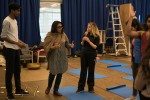Column Name
Title

The final scene from Berkeley Rep's Monsoon Wedding, which includes drama alumna Mahira Kakker (front row, first from left)
(Photo by Kevin Berne/Berkeley Repertory Theatre)Lorin Latarro (BFA ’97, dance) and I (a member of Drama Group 33) had the good fortune to work together on the world premiere of Monsoon Wedding, a musical based on the hit 2001 Indian film. The show—which is at Berkeley Rep, has been extended twice, and runs through July 16—is about a big Punjabi wedding with its attendant chaos, but it’s also about abuse, class, and different types of love. Lorin and I had a long discussion about working on a new piece, collaborating with an international and renowned creative team (led by Mira Nair, the director of both the film and the musical), and the theme of being outsiders though in different ways.
Body
I’m Punjabi and understand the culture of the show because I’ve had personal experience with it, but I’ve mostly done plays in the U.S., where I’ve lived since I came to Juilliard from India in 2000. Lorin is second-generation Italian American with a love for travel and different cultures, but her only prior experience with Indian dance was a Juilliard class on it taught by Indrani Rahman (faculty 1976-99). To prepare for the show, Lorin researched the world of Indian dance and “marinated in the culture” as much as she could. “It was a very good experience to feel like the outsider in the room—it felt like a real gift for empathy.”
“Outsider” actually meant a number of things. Monsoon Wedding’s creative team and cast were drawn from India, Canada, Australia, Japan, and the United States. The artists’ backgrounds included Bollywood, Hindustani classical music and dance, Western classical music and dance, tap, and Indian and American TV. “It’s been a learning curve—for instance having a stage actress next to someone who's never done stage before,” Lorin said. “The messiness gives our show a really great patina and makes it unique and interesting.”
While our cultural backgrounds are different, Lorin and I found we had a great deal in common because of our Juilliard training. We were linked by an approach that included humility, curiosity, respect and awareness of human complexity—values we had imbibed at Juilliard. Another value we shared was that as Juilliard artists, we were used to rigor and discipline and trying to maximize rehearsal time, so we both had to navigate a nonlinear rehearsal process where as much time was accorded to questions about authenticity and cultural nuance as it was to music and dance.
“It was a privilege to get to work on this,” Lorin said. “This cast—when we were on breaks in the rehearsal room and you guys would sing old folk songs in the corner, and it was spontaneous and real and quite beautiful. That was part of the fabric of how you grew up and so it was easy to capitalize on, but I also wanted to make sure that we were also really unzipping that” in the production. “I wanted to try and capture the sense of effervescence the culture has built in, without orientalizing it or making it feel fake.”
Lorin and I talked about appropriation in art, and I revealed that it had given me pause when I’d learned that there was a Caucasian choreographer for this Indian piece, but that after working with Lorin and her assistant, Namita Kapoor, in the audition, I realized that the rehearsal process was going to be a respectful dialogue and that my input would be welcomed.
“This is a very interesting time to be alive as an artist because I do believe that any artist should be able to tell any story,” Lorin said. “And at the same time we have to make sure that we have room at the table for peoples’ stories to be told, whose stories they actually are. So here I am, the white chick in a room choreographing a show about this authentically Indian dance—I’m so grateful that I’m accepted and thrilled to have this opportunity—but what does it mean? I'm aware of all of this—to pretend otherwise is foolish.”
We started this conversation before the show opened—and it ended up having record-breaking attendance including some people who hadn’t gone to the theater previously. “To me, this show is so important on so many levels,” Lorin said. “If we can have a South Asian audience who hasn’t been going to the theater—and we’re talking about a community that has money, so if they haven't been coming, maybe it’s because they’re not seeing themselves on stage or feel removed from what they’ve seen thus far–—so maybe this show can open doors. At the same time, we’ve got to make sure everybody else in the audience, not just 30 or 40 per cent, understands what we’re doing. And if we can do both those things it’s great for everybody. It’s really exciting to be a part of something that opens up the parameters of theater.”
The conversation with Lorin reminded me of President Polisi’s American Society and the Arts class, which Lorin and I each took at Juilliard. My takeaway was that it’s our work to perform in the service of the greater good of our community, and Lorin’s words reflected that too. “The zeitgeist is right for this show in every capacity, even politically. But I think the world is ready for it too—how audiences are accepting this show in a way is this little microcosm of how the future can look. That’s our job: to put on stage and behave in a way that we want the rest of the world to behave. We are mirrors—it sounds lofty but it’s real. This is a big deal for the future of America, and we could be a small part of that.”
Post Monsoon Wedding, Mahira Kakkar, who received her drama BFA in 2004, is taking part in a new play festival in Portland, Ore.





